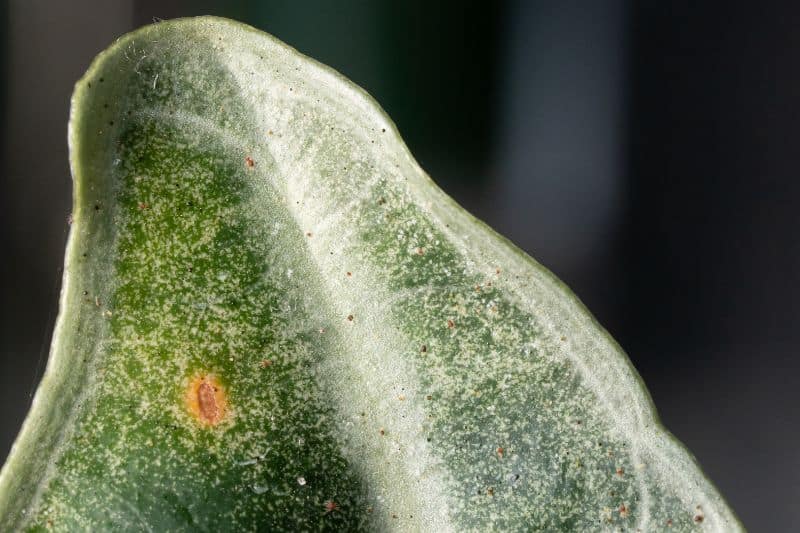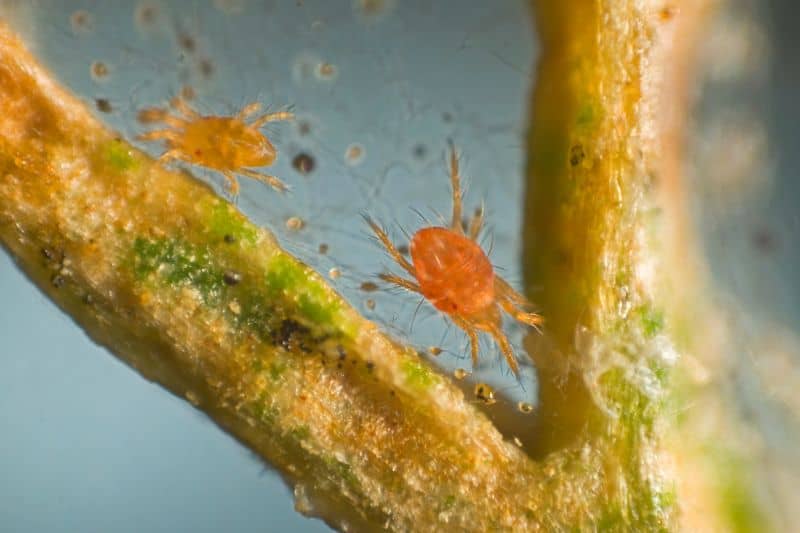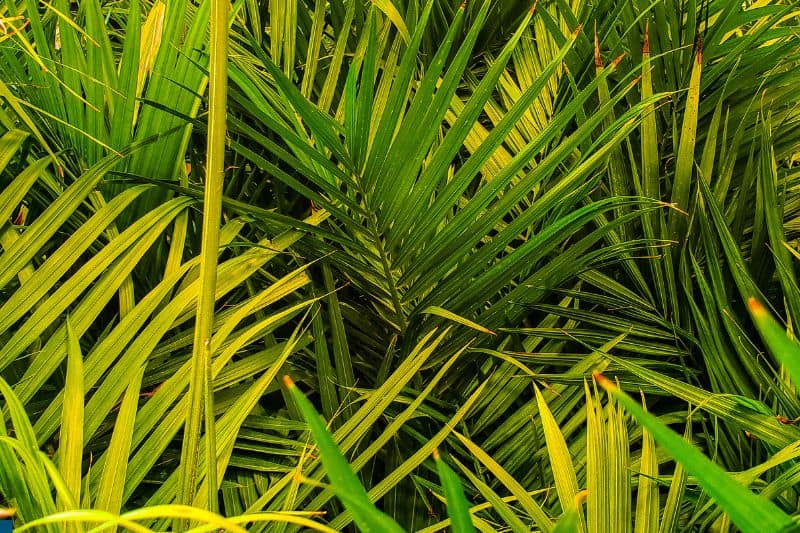Spider mite infestation! This is one of the most fear-inducing phrases any house plant enthusiast can hear. But it doesn’t have to be.
While these tiny spider-looking pests can do serious damage, combating them effectively and efficiently can save both your plant and your mind.
If you find yourself face-to-face with these notorious houseplant pests, don’t panic! Instead, take your infested plant and;
- Quarantine the plant away from others to reduce the chance of spread.
- Dunk it in water to remove and drown as many spider mites as possible.
- Spray the palm with water and dish soap, miticide, or horticultural oil.
- Create a rubbing alcohol and water mixture to spray over the plant.
Even with these techniques, removing all the spider mites from your plant can still take a few weeks. Be sure to stay vigilant and switch up which treatments you use to prevent the spider mites from becoming immune to one or the other.
Read: My Majesty Palm is Dying: What to Do?
What Can I Do if I See Spider Mites on Majesty Palm?
If you see spider mites on your majesty palm, remove it from the vicinity of any other plant to prevent the spider mites from spreading. Dunk the plant and hold it underwater in a sink, bathtub, or bucket to remove and drown the spider mites, repot the plant in fresh soil, and continue to treat the plant with spray solutions until the spider mites are gone.
Spider mite infestations can be brutal and take weeks to clear up. It’s important to always stay vigilant in your approach. If you notice the plant is not getting better or the infestation is out of control, it may be best to toss the plant and start fresh with a new one from the nursery.
However, always be sure to quarantine a new plant for at least two weeks in case it picked up any pests while at the plant store.
How To Get Rid of Spider Mites on Majesty Palm?
Getting rid of spider mites on your Majesty palm can be difficult. While you can do things to attempt to remove them, it’s best to try to prevent an infestation from the beginning.
To help prevent an infestation, you can:
- Increase the humidity around your plants by using a humidifier or spray bottle. Spider mites prefer dry and hot environments.
- Always quarantine new plants you bring into your home, as they could carry spider mites or other pests.
- Occasionally spray your plants with a pesticide or water and dish soap solution to kill any eggs on your plant or in its soil.
- Keep a close eye on your plant by checking it over during each watering session and looking for signs of spider mites.
While doing these things can help prevent an infestation, it doesn’t guarantee one won’t occur. If you find spider mites on one of your plants, you can try these methods to remove them:
- Fill your sink, bathtub, or bucket with Lukewarm water. Hold your plant under the surface of the water for a few minutes to drown and wash away as many spider mites as possible. Repeat two or three times initially and then weekly until the infestation is gone.
- Use a store-bought miticide or a homemade concoction to kill spider mites and their eggs.
- Remove the plant from its pot and throw away the dirt. Rinse the plant well under running water and repot in fresh soil.
- Keep your plant quarantined until two weeks after the last spider mite sighting to ensure the infestation is done before returning it to a place near your other plants.

What Do Spider Mites Look Like?
Spider mites are incredibly small in size — often tinier than a millimeter. Spider mites look like small spiders and come in various colors including yellow, red, black, or green. Usually, the first signs of spider mites that plant owners notice isn’t the Sadie rite itself but the tiny silk webs on the plants or the discolored bite marks on the underside of leaves.
If you notice any signs of spider mites on your plants, act fast to avoid further damage or the spider mites spreading to other house plants, causing a massive infestation.
Do Majesty Palms Attract Bugs?
Like most indoor plants, majesty palms are susceptible to pests. Aphids, scale, whitefly, and spider mites all like the palm fronds of a majestic palm. However, the plant itself does not attract bugs, making it a safe choice for a houseplant.
Spider mites are especially a concern since the majesty palm has such low humidity levels. Adding a humidifier to the room where your majesty’s palm sits is a way to combat the chance of infestation. Also, ensuring the soil isn’t overly wet will help prevent other pests from laying eggs there.
Overall, the majesty palm is a relatively low-maintenance and easygoing house plant for novice and experienced plant owners alike.

Can Plants Recover From Spider Mites?
Nothing is as scary as when our beloved house plants begin to take a turn for the worse. Whether it may be drooping or discovered leaves or the tiny webs that we notice first, spider mites is never a good sign. While noticing spider mites on your favorite houseplant can be incredibly scary, don’t panic. Most plants can recover from spider mites.
A minimally infested plant will most likely survive a spider mite infestation with little to no additional help. Remove any damaged leaves and repot the plant with fresh soil. Place the plant in a sunny spot and ensure the soil stays moist but never wet. Two weeks after repotting, you can fertilize with a house plant-specific fertilizer for an extra boost of nutrients.
Prompt and proper treatment is vital if you are hoping for your plant to make a full recovery. The longer the spider mites feast on the plant, the more it will die.
Spider mites feed on the chlorophyll in plants, which is the part of the plant cell that takes the sun’s energy and turns it into food for the plant. Once we understand the severity of what spider mites can do, it makes even more sense as to why we need to treat the infestation immediately.
Should I Throw Away Plants With Spider Mites?
While most plants can be saved from a spider mite infestation, it may be best to throw away the plant if it seems badly damaged and the leaves have all died. It is vital to remove the plant from the vicinity of other plants immediately upon discovering spider mites as they easily move from one plant to another.
If the infestation seems severe, it’s probably best to eliminate the plant. Spider mites are hard to control and can take weeks to remove on a lightly infested plant. You also run the risk of spider mites infesting other houseplants.
If you catch spider mites early enough, the plant should make a full recovery once you treat the mites. Remove the plant from any other indoor or outdoor plants as soon as you discover the spider mites. Once you treat the plant, keep it quarantined from the others for a few weeks to ensure that you truly got rid of all the spider mites as they are incredibly tiny and can be hard to see.
If the damage is extensive and most of the plant’s leaves are damaged beyond repair, the plant may not be able to recover. While you can wait it out and see if the plant will survive, keep it away from any others and treat the spider mites as soon as possible.
If you do decide to throw away your plant, be sure to attempt still to remove all the spider mites before disposal to prevent them from finding their way to other plants in your home. On the same note, never add your infested plant to compost piles as this will increase the chances of them feeding on outdoor plants when the compost is added to their soil.
Read: 15 Wonderful Plants That Keep Mosquitoes Away You Probably Didn’t Know

Can Spider Mites Infest a House?
Spider mites can easily travel from one house plant to another. They are also so small that they often go undetected until the plant begins to show signs of distress, allowing ample time for them to spread throughout your home. While they will only survive in soil, they reproduce quickly and can become an infestation within days if not taken care of.
Generally, people don’t notice spider mites until their plants begin looking stressed. They are so small that the naked eye cannot see them properly and the first sign is usually either small white dots on the underside of leaves or small webs wound around stems and leaves.
Since the infestation can happen so quickly and relatively undetected, it’s best to stay vigilant and check your plants over with each water. You can also try the dunk watering method which involves dunking your entire plant in water. This method will help drown out any spider mites that may have begun to settle in the plant.
While the dunk method won’t solve a true spider mite infestation, it’s a start. Finish off with an insecticide or spider mite spray.






